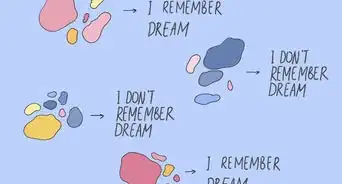This article was co-authored by Nicole Moshfegh, PsyD. Dr. Nicole Moshfegh is a Licensed Clinical Psychologist and Author based in Los Angeles, California. Dr. Moshfegh specializes in multicultural competence and treating patients with mood and anxiety disorders and insomnia. She holds a BA in Psychology and Social Behavior from The University of California, Irvine (UCI), and an MA and Doctor of Psychology (PsyD) from Pepperdine University. Dr. Moshfegh completed her predoctoral internship and postdoctoral fellowship at The University of California, Los Angeles (UCLA). Additionally, she is a member of the American Psychological Association, National Register of Health Service Psychologists, Los Angeles County Psychological Association, and Collaborative Family Healthcare Association. Dr. Moshfegh is also the best-selling author of "The Book of Sleep: 75 Strategies to Relieve Insomnia".
There are 10 references cited in this article, which can be found at the bottom of the page.
This article has been viewed 311,973 times.
Sometimes a dream can become very intense, to the extent that while in the dream you want nothing more than to wake up.[1] The problem could be that the dream has become a nightmare, or you might have a recurring dream that is boring, confusing, or uncomfortable. Although it is common to have dreams from which you would like to wake up on occasion, if these dreams happen too often, you may want to know how to wake up as soon as possible. Here are some methods that should help.
Steps
Waking Up from Your Dream
-
1Set an alarm. If you are worried you may have a dream that you will want to wake up from, set an alarm for somewhere after 90 minutes into your sleep. REM sleep happens 90 minutes into sleep,[2] and it is during this cycle of your sleep that you dream, so having an alarm rouse you might help.
- Some alarm clocks have more than one alarm you can set, so you can wake up from separate cycles of REM sleep. You can also use a mobile device, many of which allow you to set as many alarms as you like.
- Be careful not to do this too often, however, as REM sleep is a beneficial cycle of sleep that helps you process information, build memories, and replenish neurotransmitters, including chemicals that give you energy and help you feel good during the day.[3]
-
2Allow light into your sleep space. Leaving a light on or your curtains open may help interrupt especially deep cycles of sleep in which you dream, essentially making you a light sleeper and possibly helping you wake up from a dream more easily. Again, though, doing so too often might have other consequences on your usual ability to get the full benefits of uninterrupted sleep.Advertisement
-
3Call out for help in the dream. If you find you are somewhat conscious in your dream and can take action, you might try calling out in the dream. You may experience a situation where you call out in your dream, but it's more of a faint whisper. This could be because your mouth isn't open in real life. You aren't actually activating your vocal chords or using air, so no sound is actually coming out. If you concentrate, however, you might be able to speak in real life, waking yourself up.
- Think to yourself, "I'm going to actually call for help." Some people get the sensation of their brain responding with a no. Continue telling your brain that you will in fact call out for help until the sensation goes away. This might be the second or third time. At this point, try to say something. It may seem harder than usual, and that's because you are actually using your vocal chords. This time, a noise should come out, and you should wake up, realizing that it was all a dream.
-
4Blink in the dream. If calling out for help in your dream does not manage to wake you up, you might try blinking. When you blink in the dream, your eyes should close. When you open your eyes again, they may actually open in real life. Doing this may manage to wake you up, but just be careful, because this has a high chance of causing sleep paralysis. This technique requires practice, so give it a try—especially during lucid dreams (see method 2)—often so that you can be ready to utilize it should you want to wake up from a dream. Assuming the technique works for you, you will be ready to wake up in a hurry if you have mastered this technique.
-
5Jolt yourself awake. This technique also works well in lucid dreams, but even if you have not developed this ability, you may still be able to jolt yourself awake. Simply attempt to move in your dream with the hope that doing so will move your body in real life, thereby waking yourself up.
- Sleep in a position that will make it easy for you to move around.
- In the dream, try to kick your legs or move your arms around.
-
6Fall asleep in your dream. Once you know that you are dreaming, and want to wake up, simply fall asleep in your dream. This will cause you to wake up in real life.
- The easiest way to do this is to (in your dream) get on your knees with your face on the floor, and stretch your arms behind you. You'll be asleep (aka awake) in no time.
- If there are other characters in your dream around you, you might have to tell them not to distract you. It's like falling asleep in real life - you can't do it when everyone's talking.
Learning to Dream Lucidly
-
1Try to realize that you are, in fact, dreaming. This is called "lucid dreaming." Essentially, lucid dreaming is simply becoming aware of the fact that you are dreaming while you are dreaming without waking up.[4] Once you successfully achieve this, you can be in control of your dreams. Lucid dreaming makes the possibilities of your dreams endless, and minimizes the risk of an uncomfortable dream.
- Make mental notes about your surroundings/environment when you are awake. When you do this in a conscious state on a regular basis, your psyche will bring these habits into the dream state as well. Then, when you dream, you can identify details about your surroundings/environment that will serve as clues that you are dreaming. Once you achieve this, you may be able to become lucid in the dream state.[5]
-
2You can also wear something like a watch to focus on as you drift asleep. As long as it's comfortable but not so comfortable that it feels like your normal wear.
- Besides just making mental notes of your surroundings/environment, you can explicitly ask yourself whether you are dreaming or awake at various times throughout the day. Again, making a habit of such a practice will very likely carry over into the dream world so that you may recognize you are dreaming once in the dream state, should you ask yourself at that time. This is called the reflection technique.[6]
-
3Try the MILD technique. Stephen LaBerge developed the Mnemonic Induction of Lucid Dreams (MILD) technique as a means to help people achieve lucid dreaming. It requires that you try to recall your dreams as completely as possible as soon as possible after waking, then tell yourself that you will remember that you are dreaming as you fall back asleep, followed by imagining that you are already dreaming lucidly and imagining the dream itself, and repeating these steps until you are asleep and dreaming again.[7]
- If you follow these steps effectively, you may be able to become aware of the dream within the dream, thereby becoming lucid and gaining control over the dream.
-
4Prevent uncomfortable dreams. Sometimes, with enough concentration, you can determine what you will dream about before you go to sleep. This is called intentionality, and it is another means to dreaming lucidly.[8] Intentionality, actually, is part of some other methods of lucid dreaming as well, so it is a good idea to practice it as you attempt to achieve lucid dreaming, even if it alone does not end up being effective for you. It is important to note that no lucid dreaming technique works for everyone or the same for everyone. For this reason, it is a good idea to try different methods, intentionality being one.
- Intentionality basically just requires that you use your imagination to conceive of the dream you want to have.
- Imagine the place you want to be in your dream and especially how you will get there. This can help you plan, in a sense, to dream lucidly.
-
5Try a light stimulus. There are several products on the market that can help you achieve lucid dreaming through light stimuli. These products are masks that have led lights embedded in them that flash near the eyes if you wear the mask while sleeping. The idea is that you could notice the lights as you dream—particularly if you went to sleep with intentionality—and this could help you remember that you are dreaming, allowing you to become lucid in the dream.[9]
- In addition to light stimuli, there is even an app for smartphones that helps with intentionality and plays sounds that might help the dreamer become lucid during key parts of the sleep cycle.
-
6Combine different lucid dreaming techniques. Combinations of techniques to help you dream lucidly strengthen the possibility that you will become aware of the dream within the dream. In order to successfully dream lucidly, try different combinations of the various techniques to see what works for you. Some techniques have even been created via specific combinations.
- One technique combines intentionality with the mental notes mentioned above (called reality testing).[10]
- Another technique combines journaling—waking up to record dream memories in a journal—and analysis of the journal entries for common attributes with intentionality. It is called the wake back to bed (WBTB) technique.
Changing Your Dream
-
1Attempt to manipulate your nightmare away. Once you are able to achieve lucid dreaming, you may not feel the need to wake up any longer because you can change the dream into something less uncomfortable. Lucid dreaming, however, is different for everyone, and it may not be especially easy for you to change your dream—it may require practice. Nevertheless, once you have realized you are in a dream, you might be able to change things that are happening, and remove whatever is scary and make you want to wake up. This may be better than fully waking yourself up.
- Once you are lucid in the dream, you should be able to control the dream. You will have more control if you become more aware of the dream world, so pay attention to your surroundings.[11]
-
2Actively change the dream. One very straightforward way of changing the dream is by simply doing what it is you want to do. The difference, of course, is that you are in a dream, so the constraints of the real world do not apply. A common way of testing this out is to produce a brick wall and put your hand through it. Doing so is a good test of your ability to control the dream, and the realization that you are in control can empower you to change dreams that are making you uncomfortable.[12]
-
3Voice your desires inside the dream. Another way of exercising control over the dream if you are dreaming lucidly is by voicing your desires. Try saying whatever it is you want to change about the dream, and you may see results. For instance, if you are being chased, try saying that there is no one chasing you, and you may succeed in making whom or whatever is chasing you vanish. In whatever situation you may find yourself in the dream, voicing your desire to change it may work for you.
Expert Q&A
-
QuestionHow do you rewrite a nightmare?
 Nicole Moshfegh, PsyDDr. Nicole Moshfegh is a Licensed Clinical Psychologist and Author based in Los Angeles, California. Dr. Moshfegh specializes in multicultural competence and treating patients with mood and anxiety disorders and insomnia. She holds a BA in Psychology and Social Behavior from The University of California, Irvine (UCI), and an MA and Doctor of Psychology (PsyD) from Pepperdine University. Dr. Moshfegh completed her predoctoral internship and postdoctoral fellowship at The University of California, Los Angeles (UCLA). Additionally, she is a member of the American Psychological Association, National Register of Health Service Psychologists, Los Angeles County Psychological Association, and Collaborative Family Healthcare Association. Dr. Moshfegh is also the best-selling author of "The Book of Sleep: 75 Strategies to Relieve Insomnia".
Nicole Moshfegh, PsyDDr. Nicole Moshfegh is a Licensed Clinical Psychologist and Author based in Los Angeles, California. Dr. Moshfegh specializes in multicultural competence and treating patients with mood and anxiety disorders and insomnia. She holds a BA in Psychology and Social Behavior from The University of California, Irvine (UCI), and an MA and Doctor of Psychology (PsyD) from Pepperdine University. Dr. Moshfegh completed her predoctoral internship and postdoctoral fellowship at The University of California, Los Angeles (UCLA). Additionally, she is a member of the American Psychological Association, National Register of Health Service Psychologists, Los Angeles County Psychological Association, and Collaborative Family Healthcare Association. Dr. Moshfegh is also the best-selling author of "The Book of Sleep: 75 Strategies to Relieve Insomnia".
Licensed Clinical Psychologist Use your dream journal! As soon as you wake up, write as much as you can remember from your dream. Then, rewrite the nightmare so it's not some horrible scenario or outcome happening that's causing you to feel very distressed. Reread this new, positive or neutral retelling before bed so you're able to change the dream.
Use your dream journal! As soon as you wake up, write as much as you can remember from your dream. Then, rewrite the nightmare so it's not some horrible scenario or outcome happening that's causing you to feel very distressed. Reread this new, positive or neutral retelling before bed so you're able to change the dream. -
QuestionCan nightmares be warnings?
 Nicole Moshfegh, PsyDDr. Nicole Moshfegh is a Licensed Clinical Psychologist and Author based in Los Angeles, California. Dr. Moshfegh specializes in multicultural competence and treating patients with mood and anxiety disorders and insomnia. She holds a BA in Psychology and Social Behavior from The University of California, Irvine (UCI), and an MA and Doctor of Psychology (PsyD) from Pepperdine University. Dr. Moshfegh completed her predoctoral internship and postdoctoral fellowship at The University of California, Los Angeles (UCLA). Additionally, she is a member of the American Psychological Association, National Register of Health Service Psychologists, Los Angeles County Psychological Association, and Collaborative Family Healthcare Association. Dr. Moshfegh is also the best-selling author of "The Book of Sleep: 75 Strategies to Relieve Insomnia".
Nicole Moshfegh, PsyDDr. Nicole Moshfegh is a Licensed Clinical Psychologist and Author based in Los Angeles, California. Dr. Moshfegh specializes in multicultural competence and treating patients with mood and anxiety disorders and insomnia. She holds a BA in Psychology and Social Behavior from The University of California, Irvine (UCI), and an MA and Doctor of Psychology (PsyD) from Pepperdine University. Dr. Moshfegh completed her predoctoral internship and postdoctoral fellowship at The University of California, Los Angeles (UCLA). Additionally, she is a member of the American Psychological Association, National Register of Health Service Psychologists, Los Angeles County Psychological Association, and Collaborative Family Healthcare Association. Dr. Moshfegh is also the best-selling author of "The Book of Sleep: 75 Strategies to Relieve Insomnia".
Licensed Clinical Psychologist Well, that depends, as nightmares are usually related to something in your life that's been disrupting your sleep. When you wake up, write down some notes of what you remember so you can have a better sense of what exactly is happening there. If you are able to identify that it's a recurring nightmare that you're experiencing, an effective form of coping is to try to write a different ending to the nightmare.
Well, that depends, as nightmares are usually related to something in your life that's been disrupting your sleep. When you wake up, write down some notes of what you remember so you can have a better sense of what exactly is happening there. If you are able to identify that it's a recurring nightmare that you're experiencing, an effective form of coping is to try to write a different ending to the nightmare. -
QuestionWhy do I keep having nightmares?
 Nicole Moshfegh, PsyDDr. Nicole Moshfegh is a Licensed Clinical Psychologist and Author based in Los Angeles, California. Dr. Moshfegh specializes in multicultural competence and treating patients with mood and anxiety disorders and insomnia. She holds a BA in Psychology and Social Behavior from The University of California, Irvine (UCI), and an MA and Doctor of Psychology (PsyD) from Pepperdine University. Dr. Moshfegh completed her predoctoral internship and postdoctoral fellowship at The University of California, Los Angeles (UCLA). Additionally, she is a member of the American Psychological Association, National Register of Health Service Psychologists, Los Angeles County Psychological Association, and Collaborative Family Healthcare Association. Dr. Moshfegh is also the best-selling author of "The Book of Sleep: 75 Strategies to Relieve Insomnia".
Nicole Moshfegh, PsyDDr. Nicole Moshfegh is a Licensed Clinical Psychologist and Author based in Los Angeles, California. Dr. Moshfegh specializes in multicultural competence and treating patients with mood and anxiety disorders and insomnia. She holds a BA in Psychology and Social Behavior from The University of California, Irvine (UCI), and an MA and Doctor of Psychology (PsyD) from Pepperdine University. Dr. Moshfegh completed her predoctoral internship and postdoctoral fellowship at The University of California, Los Angeles (UCLA). Additionally, she is a member of the American Psychological Association, National Register of Health Service Psychologists, Los Angeles County Psychological Association, and Collaborative Family Healthcare Association. Dr. Moshfegh is also the best-selling author of "The Book of Sleep: 75 Strategies to Relieve Insomnia".
Licensed Clinical Psychologist Try to examine whether there is some stress going on in your life that is perhaps causing the nightmare to come up and try to come up with possible solutions. If it's not possible to minimize the impact of that stressor, try engaging in relaxing coping skills such as meditation, deep breathing or progressive muscle relaxation.
Try to examine whether there is some stress going on in your life that is perhaps causing the nightmare to come up and try to come up with possible solutions. If it's not possible to minimize the impact of that stressor, try engaging in relaxing coping skills such as meditation, deep breathing or progressive muscle relaxation.
Warnings
- This is if the dream occurs consecutively, if this happens, consult a physician immediately.⧼thumbs_response⧽
- If you have a nightmare disorder, consult a behavioral sleep medicine specialist so that the professional can tailor a treatment program specifically to you.[14]⧼thumbs_response⧽
References
- ↑ Nicole Moshfegh, PsyD. Licensed Clinical Psychologist. Expert Interview. 5 August 2021.
- ↑ http://www.webmd.com/sleep-disorders/guide/sleep-101
- ↑ http://www.helpguide.org/articles/sleep/how-much-sleep-do-you-need.htm
- ↑ https://www.psychologytoday.com/blog/the-superhuman-mind/201212/lucid-dreaming-and-self-realization
- ↑ https://www.psychologytoday.com/blog/the-superhuman-mind/201212/lucid-dreaming-and-self-realization
- ↑ http://www.gestalttheory.net/archive/thol_lucid1.html
- ↑ http://www.lucidity.com/LucidDreamingFAQ2.html#mild
- ↑ http://www.world-of-lucid-dreaming.com/setting-a-lucid-dream-intention.html
- ↑ http://dreamstudies.org/2012/07/06/lucid-dreaming-masks-reviewing-the-next-generation/
- ↑ http://dreamstudies.org/2012/09/18/6-best-scientifically-tested-lucid-dreaming-techniques/
- ↑ http://www.world-of-lucid-dreaming.com/
- ↑ http://www.world-of-lucid-dreaming.com/
- ↑ Nicole Moshfegh, PsyD. Licensed Clinical Psychologist. Expert Interview. 5 August 2021.
- ↑ Nicole Moshfegh, PsyD. Licensed Clinical Psychologist. Expert Interview. 5 August 2021.
About This Article
Waking up within your dreams and controlling them is an ancient practice called lucid dreaming. To do this, you’ll need to ask yourself if you’re dreaming throughout the day. Look for signs that you might be in a dream, like objects being in the wrong place, your hands looking strange, or people from your past being there. Before you go to sleep each night, you can also repeat a mantra to yourself. For instance, say, "Tonight, I will realize I'm dreaming and become conscious in my dreams." Once you get lucid in a dream, try to control the scene with your mind and your dream body. For example, if you see a monster in your dream, cover your face with your hands and imagine that when you look again it’ll be gone. Or, fly around the landscape, talk to dream characters, or rehearse an important speech to a dream audience. Getting lucid and controlling your dreams can take a lot of practice, but the possibilities of lucid dreaming are infinite. For more tips, including how to wake yourself up from a dream, read on!


















-Step-20-Version-2.webp)





















-Step-20-Version-2.webp)





































Medical Disclaimer
The content of this article is not intended to be a substitute for professional medical advice, examination, diagnosis, or treatment. You should always contact your doctor or other qualified healthcare professional before starting, changing, or stopping any kind of health treatment.
Read More...